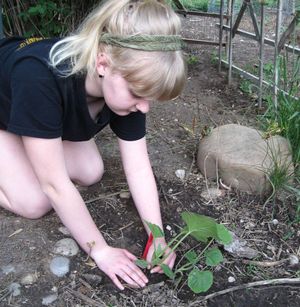One simple way to maintain the health of your vegetable garden is by rotating crops from year to year. Rotating crops means planting peas for example, in the spot where you planted your tomatoes or squash last year. Farmers practice crop rotation as a natural way to keep their farm land healthy and productive. Here’s four good reasons why us backyard farmer should consider rotating our vegetable crops as well.
Reduces chance of disease. Many of the organisms that affect plant health originate from the soil and can live in the same patch of ground for many years. This is why planting vegetables of the same botanical family in the same spot every year increases the risk of disease. Planting your vegetables in different locations will lower the risk since the organisms that feed off one type of vegetable plant may be harmless to another.
Reduces the risk of pest infestation. Just like bacteria and other soil-borne diseases, plant-specific bugs can also “winter over” to attack the same veggies if they are planted in the same location the following spring. Because I garden organically, switching around locations is one easy technique I use for curbing pest infestations. I rotate my vegetable planting on a 3-4 year cycle which is about the time it takes for a specific pest population to drop in population.
Won’t deplete soil nutrients. Plants drain soil of valuable nutrition and repeated planting of the same crop in the same area can weaken the soil so much that artificial fertilizer must be added back in. My rotation starts with shallow vegetable crops, followed by a deeper crop (such as corn) and ends with a planting of beans or peas to increase soil nitrogen.
An opportunity to experiment. Rotational planting is a great excuse for experimenting in the vegetable garden too. Instead of planting my vegetables in the same configuration year after year, I’ll switch the direction of the rows, try planting cool weather veggies in the shade of taller plants, pack them closer together or move heat loving veggies up against a south facing picket fence to see if they’ll grow faster. I also try to include at least one new crop every year just to see if it’s even worth growing. It’s through experimenting that I’ve been able to improve the overall production of my vegetable garden.
While rotational planting does take a little extra work, it is a safe and natural way to improve the health of your vegetable garden. By rotating your vegetables on a three year cycle like I do, you’ll discover that pest and disease problems can be kept to a minimum without having to use chemicals.
More by this contributor:
How to speed up seed germination.
How to create more growing space in your vegetable garden.
Eight high yield vegetables worth growing in your garden.



